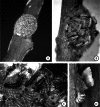The moth Hylesia metabus and French Guiana lepidopterism: centenary of a public health concern
- PMID: 22550622
- PMCID: PMC3671431
- DOI: 10.1051/parasite/2012192117
The moth Hylesia metabus and French Guiana lepidopterism: centenary of a public health concern
Abstract
The females of the moths Hylesia metabus have their abdomens covered by urticating hairs looking like micro-arrows and causing a puriginous dermatitis to humans known as "papillonite" in French Guiana and also called yellowtail moth dermatitis or Caripito itch. The densities of the moths show great seasonal and annual variations depending on mechanisms mostly unknown. When H. metabus infestations occur, numerous cases of dermatologic manifestations are reported from people living near the mangrove swamps where the moths are developing. One hundred years after the first "papillonite" epidemic reported from French Guiana in 1912, the data presented herein summarize the actual state of knowledge on H. metabus biology and ecology and on the lepidopterism. Some recommendations are proposed for the surveillance and warning systems of H. metabus infestations and to avoid contact with the moths. Research priorities are suggested to improve the control against this problem emerging between nuisance and public health.
L’abdomen des femelles du papillon de nuit Hylesia metabus est recouvert de micro-fléchettes venimeuses qui déclenchent chez l’homme une dermatite urticarienne prurigineuse, dénommée “papillonite” en Guyane. Les densités de population de cette espèce sont extrêmement variables, sous la dépendance de mécanismes qui restent mal connus. Lors des pullulations, de nombreux cas de dermatites sont observés au sein des populations humaines vivant à proximité de la mangrove où se développent les chenilles et d’où émergent les papillons. Cet article dresse un état des connaissances, un siècle après la première épidémie de papillonite connue, observée en Guyane en 1912. La biologie et l’écologie du papillon sont présentées, ainsi que les aspects dermatologiques. La surveillance et l’alerte concernant les pullulations font l’objet de recommandations. Enfin, des pistes de recherche sont avancées pour améliorer les stratégies et méthodes de lutte utilisables contre ce papillon.
Figures


References
-
- Alongi D.M.Mangroves and salt marshes. in: Coastal ecosystem processes, CRC Press, Boca Raton, FL, USA, 1998, 43–92
-
- Arias Q., Clavijo J.A., Herrera M., Osborn F. & Desousa J.C.Efecto de aplicaciones de Bacillus thuringiensis var. kurstaki, sobre la diversidad de especies de Nymphalidae (Insecta: Lepidoptera) en el Golfo de Paria estado Sucre, Venezuela, Resumen n°51. XX Congreso Venezolano de Entomología. Entomotropica, 2007, 22, 74
-
- Artigas L.F., Vendeville P., Leopold M., Guiral D., Ternon J.F.Marine biodiversity in French Guiana: estuarine, coastal, and shelf ecosystems under the influence of Amazonian waters. Gayana, 2003, 67, 302–326
-
- Battisti A., Holm G., Fagrell B. & Larsson S.Urticating hairs in arthropods: their nature and medical significance. Annual Review of Entomology, 2011, 56, 203–220 - PubMed
-
- Bauce E., Carisey N., Dupont A. & Frankenhuyzen K.Bacillus thuringiensis subsp. kurstaki aerial spray prescriptions for balsam fir stand protection against spruce budworm (Lepidoptera: Tortricidae). Journal of Economic Entomology, 2004, 97, 1624–1634 - PubMed
Publication types
MeSH terms
LinkOut - more resources
Full Text Sources
Research Materials
